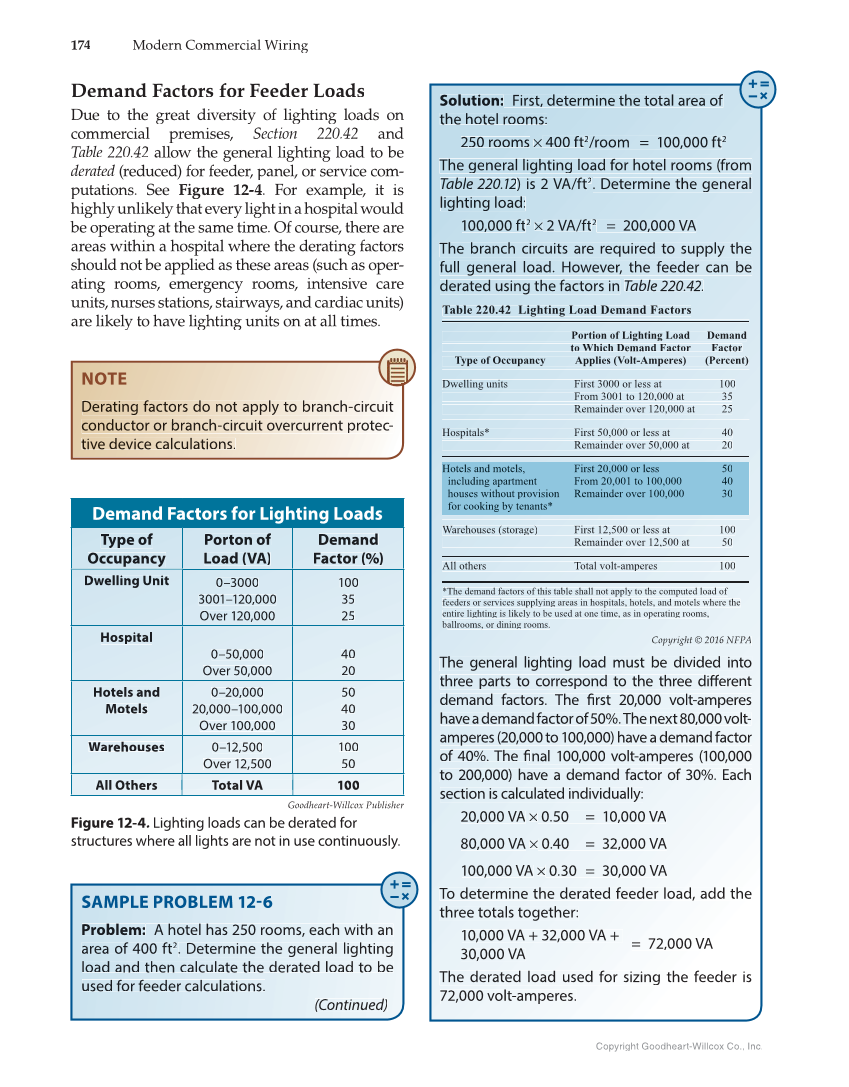174 Modern Commercial Wiring Copyright Goodheart-Willcox Co., Inc. Demand Factors for Feeder Loads Due to the great diversity of lighting loads on commercial premises, Section 220.42 and Table 220.42 allow the general lighting load to be derated (reduced) for feeder, panel, or service com- d putations. See Figure 12-4. For example, it is highly unlikely that every light in a hospital would be operating at the same time. Of course, there are areas within a hospital where the derating factors should not be applied as these areas (such as oper- ating rooms, emergency rooms, intensive care units, nurses stations, stairways, and cardiac units) are likely to have lighting units on at all times. Solution: First, determine the e total area of the hotel rooms: 250 rooms × 400 ft2/ro r oo m = 100,000 ft2 The general lighting lo l oa d for hotel rooms (from Table 220.12) is 2 VA/ft2. V A/ Determine the general lighting load: 100,000 ft2 t × 2 VA/ft2 = 200,000 VA The branch ch circuits are required to supply the full gene n er al load. However, the feeder can be derated te d using the factors in Table 220.42. Tab a bl e 220.42 Lighting Load Demand Factors Portion of Lighting Load Demand to Which Demand Factor or Factor Type of Occupancy Applies (Volt-Amperes re s) (Percent) Dwelling units First 3000 or less at at 100 From 3001 to 120 20, 000 at 35 Remainder ov o ver 120,000 at 25 Hospitals* First 50,00 ,0 00 or less at 40 Remain ai nde r over 50,000 at 20 Hotels and motels, First 20,000 or less 50 including apartment From 20,001 to 100,000 40 houses without provision Remainder over 100,000 30 for cooking by tenants* Warehouses (storage g e) First 12,500 or less at 100 Remainder over 12,500 at 50 All others Total volt-amperes 100 *The dem ema nd factors of this table shall not apply to the computed load of feeders er s or services supplying areas in hospitals, hotels, and motels where the enttir ire lighting is likely to be used at one time, as in operating rooms, ba b all rooms, or dining rooms. Copyright © 20 201 6 NFPA The general lighting load must be divid vi de d into three parts to correspond to the thre hr ee different ff ff demand factors. The fi rst 20,000 0 volt-amperes fi have a demand factorof 50%. Thenext he 80,000 volt- amperes (20,000 to 100,000) have ha a demand factor of 40%. The fi nal 100,000 volt-amperes v (100,000 fi to 200,000) have a dema m an d factor of 30%. Each section is calculated ind n di vidually: 20,000 VA × 0.50 5 0 = 10,000 VA 80,000 VA × × 0.40 = 32,000 VA 100,000 0 VA × 0.30 = 30,000 VA To determine er the derated feeder load, add the three e t to tals together: 10,000 VA + 32,000 VA + = 72,000 VA 30,000 VA The derated load used for sizing the feeder is 72,000 volt-amperes. NOTE Deratin ng factor o rs do not t a ap ply to branch-c ci rcuit condu uc tor or branch-circuit b i rc overcurrent er p pr otec- tive device d calculations. ca ns Goodheart-Willcox Publisher Figure 12-4. Lighting loads can be derated for structures where all lights are not in use continuously. Demand Factors for Lighting Loads Type of Occupancy Porton of Load (VA) Demand e ma F Fa ctor (%) Dwelling Unit 0–3000 30 00 300 30 01 –120,000 Over 120,000 100 35 25 Hospital Ho 0–50,000 Over 50,000 40 20 Hotels and Motels 0–20,000 20,000–100,000 Over 100,000 50 40 30 Warehouses 0–12,500 Over 12,500 100 50 All Others Total To ta l VA 100 SAMPLE PROBLEM 12-6 Problem: A hote t el has 250 rooms, each with w an area of 400 ft2. D De termine the general lighting i load and then c ca lculate the derated load d to be used for feeder calculations. (Continued) n
